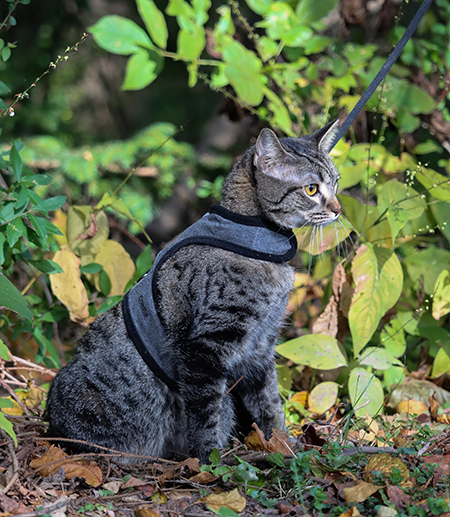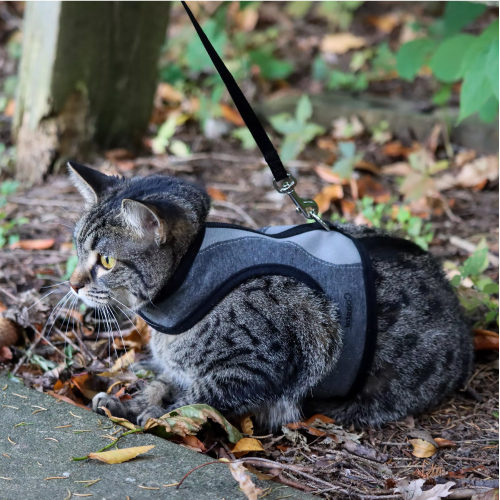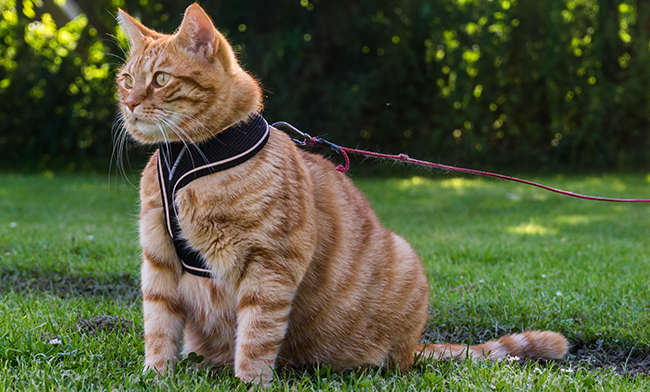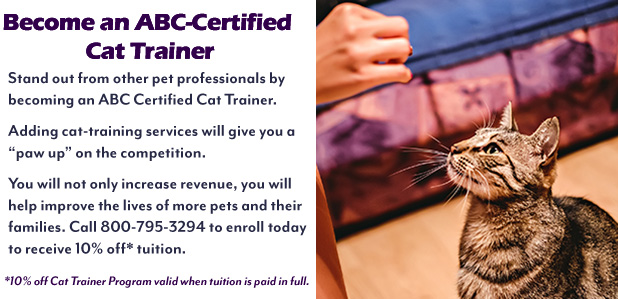By Coastal Pet Products Staff
 Dogs are not the only domesticated animals who like to explore outdoors. Cats like to adventure outside not only for exercise, but to experience new sights and smells. They can get out safely with leash training.
Dogs are not the only domesticated animals who like to explore outdoors. Cats like to adventure outside not only for exercise, but to experience new sights and smells. They can get out safely with leash training.
Before a client starts to leash train a cat, it is important they keep in mind cats will not walk on a leash like dogs do. Instead, they tend to take the lead and go in whichever direction is most interesting to them.
If a client is just getting started with the leash training process, Coastal Pet Products Inc. offers a variety of cat and kitten harnesses and leashes to choose from. The Adjustable Cat Wrap Harness (image right) is a good option as it is made from breathable fabric that fully adjusts to accommodate each cat’s unique shape. It ensures a snug fit which helps to reduce anxiety, and it even comes with a 6-foot leash.
Leash training is going to take patience, persistence, practice and praise.
Familiarize
When leash training a kitten or a mature cat, the first step is familiarization. The cat needs to get used to the harness as an object before they can be comfortable wearing it. The best way to familiarize a cat with the harness is to place it among their toys, on the floor near their food or simply give it to them to smell. By taking things slow and allowing the cat to get familiar with the harness, it shows them that it is nothing to be afraid of.
Put the Harness On
Once a cat is familiar with the harness as an object, have your client put it on her. In most cases, this will be a struggle, but it is normal. The client should remain calm and once the harness is on, reward their cat with treats. They should leave the harness on their cat for a few moments and then remove it. This is when persistence comes into play. The next day, have them leave the harness on their cat for a bit longer than they did previously. Each day, they should increase the amount of time the harness is on. While the harness is on, it is time for praise. Have the client give their cat whatever she is most responsive to, like pets or treats. This process can take a few weeks until a cat barely reacts when the harness is on.
Attach the Leash
Then it is time to attach the leash. The first few times it is attached, your client should not hold onto it. Instead, they should let their cat drag the leash so she can get used to the tugging feeling it creates. As they did with the harness training, they should praise their cat with the leash attached until she is unbothered by it.
Hold the Leash
Before a client takes the cat outside, they should start following behind her while holding the leash. They can try to gently guide their cat by stopping its movement forward, and then redirecting by gently tugging in a different direction. This act will be helpful when outdoors if a curious cat is headed toward something that is not safe. If their cat follows the corrective suggestion, they should reward her. If the cat does not follow the correction, they should try placing a treat on the floor in the direction they want her to go for incentive. Have them practice this a few times; however, it does not need to be perfected before hitting the great outdoors. Some cats are natural leaders who go their own way and that is OK, too.
Go Outside
 As your clients prepare to head outdoors for the first time, let them know that they should always pick up their cat and carry her outside. This helps a cat know their owner is in control and prevents her from wanting to run out of the door any time it is open whether she has her leash and harness on or not.
As your clients prepare to head outdoors for the first time, let them know that they should always pick up their cat and carry her outside. This helps a cat know their owner is in control and prevents her from wanting to run out of the door any time it is open whether she has her leash and harness on or not.
The first time a cat is taken outside, advice your client to not go too far if not necessary. A front or backyard is a wonderful place to start. Have them find an area with minimal distractions – no loud noises, free from other pets and people. Their cat will let them know when she is ready to venture back indoors. Signs like ears back, fluffed tail, and not wanting to move mean a cat is fearful of the situation. Positive reinforcement, like treats or petting, can be tried, but if a cat is too scared, they may not respond. This is another time for patience and practice – they can always try again the next day.
Depending on the cat, she might be an active outdoor explorer that goes in any direction of interest, or she may be more relaxed and simply enjoy lounging in the sun or chewing some grass. No matter which personality, the time outside is beneficial not only for the cat, but for their owner as well.







